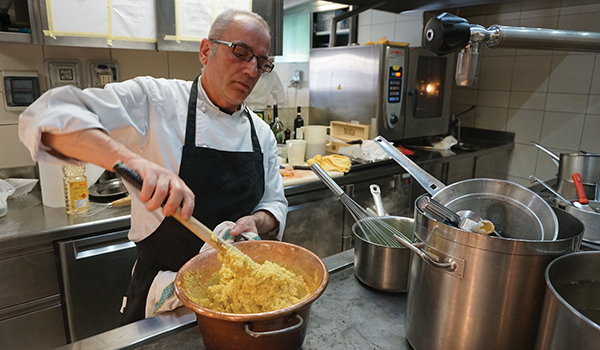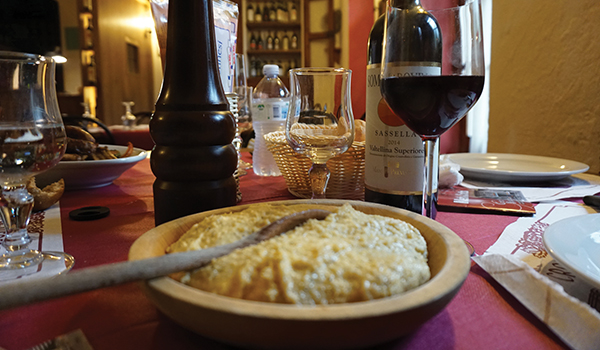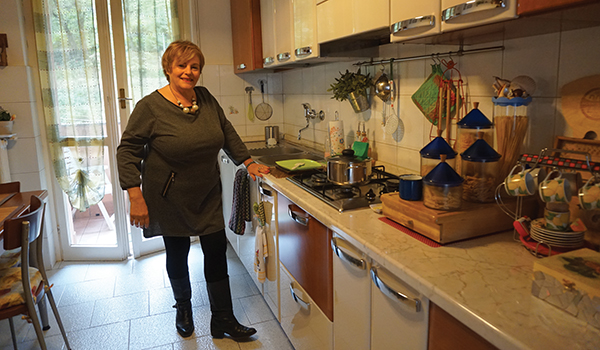Rachael Martin continues her story of what living in Italy has taught her about food, moving on from pasta and risotto to polenta…
The days get colder, wild mushrooms are picked and chestnuts roasted. Pumpkins have made their way into shops and risottos. Then autumn is about to give way to winter and Christmas is nearly here. Panettone and pandoro appear on supermarket shelves and children go to school on a slice of panettone and a glass of milk. People are cooking more hearty pasta dishes, polenta served dripping with butter and cheese or with various stews. And minestrone.
No Italian home is complete without its weekly minestrone – except ours, I always want to add. The kids pull a face.
Polenta makes you happy
Then there’s polenta. La polenta ti fa contenta, or polenta makes you happy, as the mother of a friend who came from the mountains above Valchiavenna and was renowned for her hearty mountain cooking used to say. And it does. What could be more comforting than a dish of steaming polenta with a stew of venison or wild boar up in the mountains, or even just good old beef?
Yet the polenta that has become so fashionable in chic restaurants was once associated with extreme levels of poverty in Italy. Sometimes it was all you ate and, as a result, hunger was rife. The stews and other meat dishes with which we enjoy polenta now were, if you were lucky, reserved for feast days and other occasions. Polenta is to the north what pasta is to the south. It’s not that you don’t eat both all over Italy – Italian food may be region-based but it still has a certain national cohesion – but historically, and particularly in the north, it was a way of filling stomachs cheaply.

There are many ways to eat polenta and each region has its own variation, yet the method of cooking it remains the same. Ideally, you need a large copper pan and a lot of patience as polenta needs stirring for about forty minutes, unless you have an electric polenta-stirring appliance to do it for you.
My favourite polenta dish is polenta taragna, buckwheat polenta mixed with corn polenta with lots of melted-in mountain cheese and butter. It is to be found in the mountains of the Valtellina, in Bergamo and in Brescia.

Then there’s polenta uncia or concia. It’s known as uncia if you’re living in the provinces of Lecco, Como and Bergamo, concia if you’re out towards Val d’Aosta. Essentially, it’s the same though: corn polenta cooked with cheese and butter. What changes is the type of cheese used in its preparation.
If you ever have any leftover polenta, it can be sliced and grilled or made into polenta pasticciata. Slice it and put it in a dish, cover it with sugo and any cheese you have, and warm it in the oven. Any sugo – tomato-based sauce – will do, whether it’s ragù, contains Italian sausage or pancetta, with vegetables or simply just the classic tomato sauce.
You can also make polenta ‘pizza’. Cut any cold, leftover polenta into squares or rectangles, spread over a bit of Italian tomato sauce (or even just a good-quality ready-made tomato passata if you have no sauce to hand) top with slices of mozzarella, add any other toppings you wish, and pop it under the grill.
Go to any restaurant serving cucina tipica (traditional cooking) and chances are polenta will have a place somewhere. Celebrity chefs may be serving up new ways of interpreting traditional recipes, but people still love to go out and eat the original. Similarly, the plates of spaghetti and tomato sauce that were a symbol of economic well-being in the 1960s still feature regularly on people’s tables, as do meatballs. But not with pasta. Pasta with meatballs, as delicious as it is, is not Italian. It’s an extremely popular Italo-American dish.
What are more authentic are meatballs known as mondeghili, a classic example of how Italy’s political history has shaped its culinary history. The mondeghili, which are a favourite of the Milanese, originally come from the Spanish albondigas, which originally came from the Moorish al-bunduc. The Spanish brought them to Milan during their domination of the Duchy of Milan. Mondeghilli were simply a way of using up the meat from your Sunday joint, whether it be pot-roasted or boiled. Francesco Cherubini in his Milanese-Italian dictionary of 1839 describes them as: “a type of meatball made with leftover meat, bread, egg, and similar ingredients,” which tradition recommends as sausage, salami, mortadella, grated cheese, and preferably salami. The meatballs are then shaped and fried in butter.
Giovanni Rajberti in his 1850 book The Art of Entertaining Made Smple for the Masses refers to Milan as the “capital of meatballs,” and meatballs are still very popular on menus or as part of the Milanese aperitivo.Of course they aren’t the only type of meatball you’ll find, and what was once a way of using leftovers has
now become a dish in its own right. And whether you like yours fried or in tomato sauce, with beef or chicken or even fish, the options are endless.
Open recipes
One thing that is so apparent here in Italy is that Italians are very attached to their food. They’re attached to their recipes, and recipes aren’t necessarily fixed. As Italian chef and TV personality Carlo Cracco has said: “A recipe is never closed. A closed recipe doesn’t make sense, it should always be open – also depending on what you find at the market.”
Food contains memory of a people in a particular time and place and it’s this that we evoke, remember and preserve when we cook traditional recipes. It also contains memory of an individual within a personal context. The food we eat changes throughout our lives, according to what’s popular or fashionable at the time.
You can live in a place for many years, but you still keep within you the places where you once were. I only have to look along my bookcases see this. My mother’s 1959 edition of Warne’s Everyday Cookery sits next to 1,001 ricette della nonna – 1,001 of Grandma’s Recipes. Further along there’s the Dairy Book of British Cookery next to Pellegrino Artusi’s L’Arte di mangiar bene –
The Art of Eating well.
Of course these are just the books. It’s in the food itself where it all comes together. Just as a country takes on dishes through its history, we too are influenced. Every year, Ada continues to cook fish for her family on Christmas Eve at the evening meal with which southern Italians traditionally celebrate Christmas. I make a large sausage roll and trifle and take it along to my mother-in-law’s. We both share in our own ways a part of ourselves, and continue these traditions for our children.
In contrast with other countries, Italy has been slow to take up the global food culture. While Italian cooking is one of the greatest exports that Italy has sent out into the world, Italy itself is not only valuing its own recipes but also its smaller-scale producers. Home cooking still rules. Maybe this is what I’ve learned since I came here nearly twenty years ago and used to sit at various tables, soak it all up and love every minute, barely yet understanding what it really all meant. Food matters, your own food matters. Culture, identity, experience and place all make their way onto our plates in a celebration of who we are, and this is what Italians are so good at.
Ada’s piatti poveri from the south
My neighbour Ada has lived in the countryside north of Milan for nearly forty years but she still cooks the recipes she ate when she was growing up as a girl in Salento, just south of Naples. “The way
I cook is how I ate as a girl,” she explained to me. “Essentially, it was poor food, but it was so good.”

I’ve known her since we moved to our current home. When I made wedding favours of homemade sundried tomatoes, it was Ada who told me how to prepare them. I remember when my children were babies, how the smells from her kitchen would rise up through the windows. Sometimes she’d stop me as I was going up the stairs. “Try this, I made it today,” she’d tell me and hand me a dish of something she’d just cooked. Ada’s cooking is testimony that you need very little to produce good food. The beauty and the flavours of a dish lie in its simplicity.
When Ada was a girl her mother worked and she was brought up with her grandmother. She was always in the kitchen with her grandmother. She’d knead the dough and clean the vegetables. “These were the games I played with my grandmother,” she tells me. She also remembers the three-metre-long table where all the family would eat together on special occasions. She grew up surrounded by her extended family in what she remembers as a very matriarchal family focussed within the kitchen. The recipes she remembers are piatti poveri, food of the poor. Even though her family were relatively well off compared to some, meat was still only eaten once a week and the majority of dishes focused on pasta, bread, vegetables and fish. Her grandfather had a stable for horses and they had rabbits, hens, a nearby well and a wood oven.
Ada would sit with her grandmother shelling peas and broad beans. They’d prepare pasta e fagioli (pasta with beans) and pasta e cavolfiore (pasta with cauliflower, see the cooking method below), and the classic spaghetti aglio, olio e peperoncino, spaghetti with garlic, oil and chilli. “Always add a ladle of the cooking water for the pasta,” she tells me. “It’s this that mixes it, brings the whole thing together.”
She tells me about the snacks her grandmother used to prepare when she came home from school, white bread made slightly wet with water and then sprinkled with sugar and ground coffee. Her grandmother also used to prepare friselle, twice-baked bread from southern Italy. Ada gives me her recipes. She makes one version with tomatoes, chopped and dressed with oil, salt and oregano. The other is made with beans, using a soffritto of garlic, chilli and oil. Fry garlic, chilli and oil first, then add a tin of borlotti beans in their juice (“Just drain off the top bit,” she tells me) and the friselle bread in pieces towards the end. Her dishes encompass everything that makes Italian cooking so good. They’re simple, easy and delicious.
